It Was Failing to Do More on Diversity, Editor Writes
Updating: Post Offering Buyouts to Cut Staff by 240
Homeowners Gave Jim Crow His Comeuppance
Short Takes: Black journalist history at Chicago Sun-Times; Chicago Public Media-Chicago Sun-Times; HBCU internship for covering auto industry; Robert Menendez; Indigenous Peoples Day; E.R. Shipp and Morgan State U. shootings; Mark Russell; Ibram X. Kendi, Mikki Kendall, Nikole Hannah-Jones, Ta-Nehisi Coates and Banned Books Week; Alan Sealls; Kerwin Speight; Reporters Committee for Freedom of the Press; Black History Month in the U.K.
Homepage photo: Martin Baron at March 2014 Journal-isms Roundtable, by Jason Miccolo Johnson
Support Journal-ismsDonations are tax-deductible.

It Was Failing to Do More on Diversity, Editor Writes
Failing to try to secure the resources to properly address diversity issues “was regrettably the most serious error of my tenure” as executive editor of The Washington Post, Martin Baron, top editor at the news organization from 2013 to 2021, declares in his new book, “Collision of Power: Trump, Bezos, and The Washington Post.”
In perhaps the most complete account of the internal turmoil over racial issues at the newspaper in the period before and after the police murder of George Floyd in 2020, Baron also discloses that he wanted Kevin Merida, his managing editor and the first Black journalist in the role, to succeed him as top editor. Baron said he even offered to retire two years earlier than planned so that Merida would be in line for the job.
“I was heartbroken when he informed me in October 2015 that he was leaving to take a high-paying job as senior vice president of ESPN and editor in chief of The Undefeated, its digital site centered on the intersection of sports, race, and culture,” Baron wrote.
“I had done everything possible to keep him. We had raised our compensation offer as high as possible, And then I privately told Kevin that I was willing to retire early — in two years — if he stayed, with the goal of him becoming my successor. I suggested he use those years to build relationships with the publisher and hone digital and business skills that would make him the preferred candidate.
“Kevin’s departure was a blow not only to me but also to the morale of Black journalists on our staff, made worse by his move to recruit a half dozen of them to his new employer (at substantial higher salaries.)”
Five years later, “in a mood of despondency in June 2020, I offered publisher Fred Ryan my resignation. Working alone from home during the pandemic, I suggested to Fred that he lure Kevin Merida back from ESPN and name him as my replacement. Kevin, I emailed him, was ‘better equipped than I to lead this newsroom through the fraught period we are in. . . . Fred refused my resignation offer . . .’ “
Merida left ESPN in 2021 to become executive editor at the Los Angeles Times. Sally Buzbee, executive editor at the Associated Press, succeeded Baron that year.
Merida messaged Journal-isms on Sunday, “It was an agonizingly difficult decision to leave The Post, my home for 22 years, and a place where I had developed many close relationships. It’s something I have talked about publicly. The decision was made all the more difficult because of the strong partnership I had with Marty. I loved working with him, learned a lot from him, and we remain good friends.”
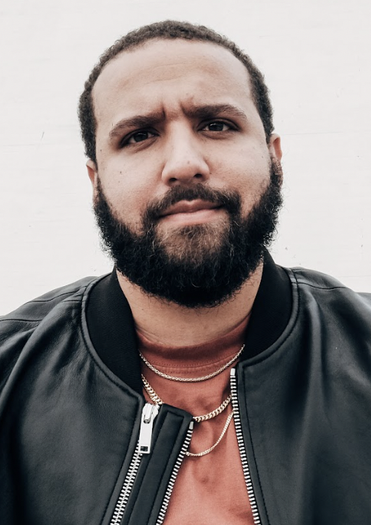 Baron also devotes several pages to his dealings with Wesley Lowery (pictured), another Black journalist, in a larger discussion of appropriate use of social media and the Post’s policies on what it considers advocacy by reporters. Lowery, hired from the Boston Globe when Lowery was 23, raised his profile in 2014 with his reporting from Ferguson, Mo., after the fatal shooting of Michael Brown, an unarmed Black man, by a white police officer. Lowery and Huffington Post reporter Ryan Reilly were briefly arrested.
Baron also devotes several pages to his dealings with Wesley Lowery (pictured), another Black journalist, in a larger discussion of appropriate use of social media and the Post’s policies on what it considers advocacy by reporters. Lowery, hired from the Boston Globe when Lowery was 23, raised his profile in 2014 with his reporting from Ferguson, Mo., after the fatal shooting of Michael Brown, an unarmed Black man, by a white police officer. Lowery and Huffington Post reporter Ryan Reilly were briefly arrested.
“Not only did Wes have to endure tear gas and rubber bullets while witnessing protesters’ injury and grief, he endured invective on social media, on air, and from right-wing critics intent on tormenting him and disparaging The Post,” Baron wrote. “It would have been a lot for anyone to handle; more so for someone at the start of his career.
“Post journalists are expected to take a lot of shit, mostly suppressing their emotions and continuing with their work. That was not Wes’s approach To his nastiest critics, he responded in kind, provoking more attacks. He didn’t handle it according to our standards.”
In 2019, Lowery, who had amassed hundreds of thousands of Twitter followers, used his account to blast the media as “cowardly” for not immediately using the term “racist” to describe then-president Donald Trump’s attacks on four progressive congresswomen of color. Trump called on them to “go back” to the “totally broken and crime infested places from which they came.”
The tweet seemed aimed particularly at The Post, Baron wrote, adding that Post practice was to have “considerable discussion” before using such a term. “Within a day, managing editor Cameron Barr assembled a diverse group to thoroughly discuss whether to label Trump’s comments ‘racist.’ ” We made the decision to do so. Deliberativeness isn’t cowardice; it’s a guardrail against the perils of impulsiveness,” Baron asserts.
After other such examples, Baron describes a confrontational meeting with Lowery in his office and a subsequent letter in which the reporter “claimed that his championing of diversity in hiring and coverage ‘appears to increasingly run afoul’ of The Post’s expectations for reporters’ behavior.”
Baron responds, “The Post then employed 850 news department reporters and editors. If each of them acted both as a newsperson and commentator, it would be a cacophonous, unprofessional mess.”
He added, “We wanted Wes to keep working at The Post. Our view of him as a talented journalist was not at all diminished. But in January 2020, several months after receiving the first and lightest variant of formal discipline, an aggrieved Wes informed us that he would be quitting in a few weeks to take another job.”
Lowery, now an associate professor of investigative journalism at American University, executive editor of its Investigative Reporting Workshop, and a freelance writer and author, told Journal-isms Sunday that he did not want to comment. However, when Baron departed in 2021, Lowery both praised and criticized his former boss in Columbia Journalism Review.
In “Collision of Power,” Baron correctly notes that the Post was not the only newsroom where Black journalists personally felt the pain of the nation’s racial climate, including but not limited to the George Floyd murder. Baron referenced The Philadelphia Inquirer, Los Angeles Times, The Wall Street Journal, The New York Times and ESPN.
After the Floyd murder and Black Lives Matter protests, Baron writes, he congratulated the staff on “covering a story that tested their stamina and threatened their safety.”

But “I quickly learned, though,” that the congratulations were “not well-received. I had written of the racial justice protests as if they were just another huge story, failing to recognize that they were far more than that. I had omitted any mention of the deep pain felt by our Black journalists. The killing of George Floyd represented more than an act of police brutality. It was emblematic of the injustices, indignities, and inequities they themselves had experienced in their own lives. To them, the story was personal.
“And my failure to grasp that and reflect that was, in their view, symptomatic of what was missing in our own newsroom: No Black journalists among three managing editors and two deputy managing editors. Too few among department heads. Too few overall in our newsroom. Coverage that failed to adequately communicate the Black experience. Not enough leaders who were able to see the world from a Black perspective. Leadership that had not done nearly enough to set things right.”
In June 2020, the Post held a virtual town hall with employees. Some Black staffers had already been meeting among themselves.
According to Baron, attendees asked, “Will The Washington Post make a statement in regards to George Floyd’s death at the hands of police?” “What does The Post plan on doing to support its Black reporters during this trying time?” “What specifically is The Post doing to prioritize hiring more people of color?” “Other large organizations have persons and leadership positions dedicated to promoting diversity and facilitating tough conversations and change. What structural/management changes is The Post making to do the same?” “Are donations to Black-centered charities such as Black Lives Matter allowed under company policy? If not, can a policy change be revisited?”
 Meanwhile, “One reporter, Jessica Contrera (pictured), said that she had ‘decided to reach out to my colleagues and former colleagues of color, asking them to share their stories with me, through a Google submission form. She was now forwarding their accounts in the form of a thirty-two page compilation of their experiences over a long period with The Post, including ones that preceded my editorship. ‘Certainly,’ she wrote us, ‘I have heard stories and snippets of discrimination or racism in our company that made me shudder. But I hoped — as perhaps you have — that those situations were rare. They are not.’ “
Meanwhile, “One reporter, Jessica Contrera (pictured), said that she had ‘decided to reach out to my colleagues and former colleagues of color, asking them to share their stories with me, through a Google submission form. She was now forwarding their accounts in the form of a thirty-two page compilation of their experiences over a long period with The Post, including ones that preceded my editorship. ‘Certainly,’ she wrote us, ‘I have heard stories and snippets of discrimination or racism in our company that made me shudder. But I hoped — as perhaps you have — that those situations were rare. They are not.’ “
“The Washington Post Guild, the union that represents employees in the newsroom and in certain commercial operations, sent its own ’11 evidence-based, actionable solutions . . . to address discrimination and inequality at The Post. ‘Employees, said its letter signed by 450 employees, ‘deserve leaders who are clear-eyed about the reality of racism and take ownership of the systemic bias that exists in our company.”
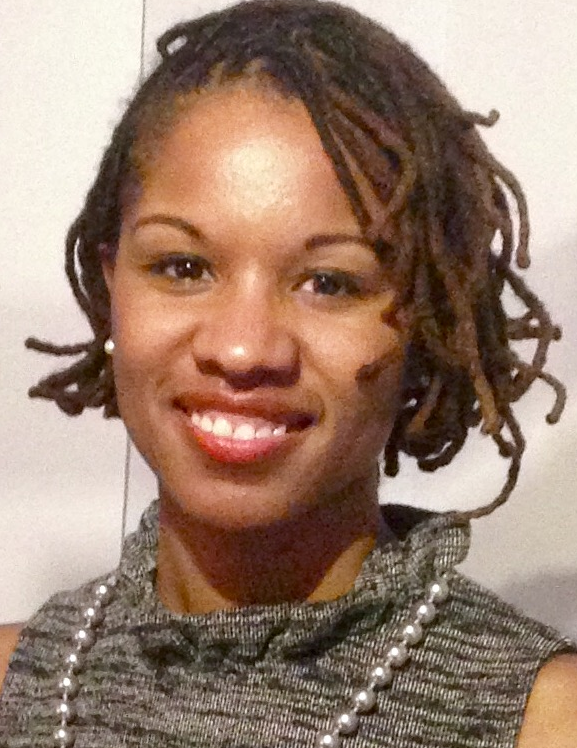 The upshot was an announcement in June 2020 of “the creation of new roles designed to enhance coverage of the growing national discourse on race in this historic moment and beyond, including a Managing Editor for Diversity and Inclusion, a senior leadership position with responsibilities such as convening regular coverage discussions focused on race and identity and the identification and recruitment of candidates.” That post would go to Style section reporter Krissah Thompson (pictured).
The upshot was an announcement in June 2020 of “the creation of new roles designed to enhance coverage of the growing national discourse on race in this historic moment and beyond, including a Managing Editor for Diversity and Inclusion, a senior leadership position with responsibilities such as convening regular coverage discussions focused on race and identity and the identification and recruitment of candidates.” That post would go to Style section reporter Krissah Thompson (pictured).
Baron’s recounting of the events comes with at least one mea culpa. “I had not been the good listener I regularly urge others to be. Black journalists at The Post were telling me we had not done nearly enough — that their voices weren’t being heard at senior levels and that our diversity efforts needed to go deeper than a top-level appointment or overall numbers,” Baron writes. “I should have assessed our newsroom with a wider lens. Our immediate growth needs were existentially pressing, but other needs should not have been ignored. Whether I expected to be successful or not, I should have advocated for a top-level editor who could lead our diversity efforts, not just for purposes of hiring but also to strengthen our coverage of long-standing, unresolved issues of race, ethnicity, and identity. Success at getting the resources might have eluded me, but failing to try was regrettably the most serious error of my tenure at The Post.“
The news organization has produced some outstanding journalism about race since then. However, the Washington Post Guild found in 2022 that “While The Post has made some progress closing the pay gap since our last study, women and people of color are still paid less compared with their male and White colleagues,” adding, “Though the company seems to be making a concerted effort to hire more people of color, it is not retaining them.”
A July snapshot of the diversity of the Post’s newsroom showed, in the major categories, whites to be 47 percent of all employees and 58.8 percent of leadership; Blacks or African Americans 22.6 percent of all employees and 18.7 percent of leadership, Asians 14.7 of all employees and 8.6 percent of leadership, and Hispanics or Latinos at 8.1 percent of all employees, 6.8 percent of leadership.
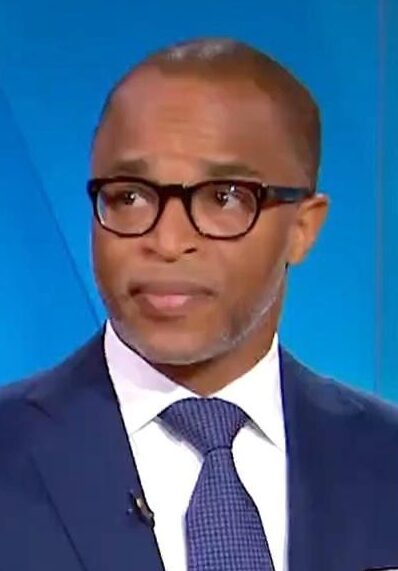 Among concerning indicators, some privately question whether the managing editor for diversity and inclusion could be more aggressive and influential; the Foreign Desk has no Blacks or Hispanics (scroll down), saying that current Black and Hispanic newsroom staffers are not willing to go abroad; and most recently, the paper failed to tell its Black print edition readers of a study that confirmed that fellow African Americans find mainstream media coverage as wanting as they do. (The Washington Association of Black Journalists convened a membership meeting with the authors to discuss the report.)
Among concerning indicators, some privately question whether the managing editor for diversity and inclusion could be more aggressive and influential; the Foreign Desk has no Blacks or Hispanics (scroll down), saying that current Black and Hispanic newsroom staffers are not willing to go abroad; and most recently, the paper failed to tell its Black print edition readers of a study that confirmed that fellow African Americans find mainstream media coverage as wanting as they do. (The Washington Association of Black Journalists convened a membership meeting with the authors to discuss the report.)
Baron rejects the contention by some that journalists should be permitted to bring their “full selves” to work, and he closes his chapter titled “Uprisings” by urging diversity, but also “good journalism.”
“One argument among journalists was that under the old rules they could not bring their ‘full selves’ to work, forcing them to be one version at home and another in the office,” he writes. “But that sort of thinking wasn’t something they’d likely tolerate from certain other professions — judges or police, for example. Or, for that matter, from colleagues who might embrace ideas that most in the newsroom would find objectionable. Or from their own newsroom supervisors. I can only imagine the reaction among staff if I, as executive editor of The Post, had chosen to march for a cause that ran counter to the views of many in our newsroom. . . .”
Baron adds, “One goal of greater diversity had to be inclusiveness: Allowing all Americans to see themselves, their concerns, and their aspirations more accurately and fully reflected in our stories.
“Another had to be understanding: Giving Americans the means to see the world from the vantage point of others whose background and experiences were very different from their own.
“However, participation by journalists in the very events our news organizations covered — whether through marches or donations or social media — risked undermining public confidence in the independence and professionalism of our work. The cause of public understanding would not be well served if our journalists were seen as indistinguishable from activists. Within the news department at The Post our mission was to inform, not to advocate. Good journalism would have to do the talking, as it had for decades. For us, there was no more effective form of speech.”
Updating: Post Offering Buyouts to Cut Staff by 240
“The Washington Post announced plans Tuesday to offer voluntary buyouts to its staff, in an effort to reduce head count by 240,” Will Sommer and Elahe Izadi reported Tuesday for The Post.
 “In an email to staff, interim CEO Patty Stonesifer wrote that The Post’s subscription, traffic and advertising projections over the past two years had been ‘overly optimistic’ and that the company is looking for ways ‘to return our business to a healthier place in the coming year.’ (Photo: Washington Post building,)
“In an email to staff, interim CEO Patty Stonesifer wrote that The Post’s subscription, traffic and advertising projections over the past two years had been ‘overly optimistic’ and that the company is looking for ways ‘to return our business to a healthier place in the coming year.’ (Photo: Washington Post building,)
“The Post currently employs about 2,500 people across the entire company. A staff meeting is planned for 10 a.m. Wednesday to discuss the buyouts, which will be offered to employees in specific jobs and departments. . . .”
“Stonesifer added that the buyouts are being offered in hopes of “averting more difficult actions such as layoffs — a situation we are united in trying to avoid.” . . .
“The steep cuts at The Post come as the newspaper is set to lose $100 million this year, as first reported by the New York Times. . . .”
In a statement from the Washington Post Guild, posted by Andrew Beaujon on the Washingtonian magazine site, the union said, “We are infuriated about this decision and concerned for our dedicated, brilliant colleagues. Today’s announcement comes after at least 38 people were laid off over the last year.
“Hard-working Post employees are going to lose their jobs because of a litany of poor business decisions at the top of our company. We cannot comprehend how The Post, owned by one of the richest people in the world, has decided to foist the consequences of its incoherent business plan and irresponsibly rapid expansion onto the hardworking people who make this company run. . . .”
- Jennifer Bowers Bahney, Mediaite: Jake Tapper Confronts Ex-WaPo Editor For Suspending Reporter Over Kobe Bryant Tweet: It ‘Was Journalism’
- Martin Baron, The Atlantic: How We Got ‘Democracy Dies in Darkness’
- Geoff Bennett and Stephanie Kotuby with Martin Baron, “PBS NewsHour”: Martin Baron examines The Washington Post during the Trump era in ‘Collision of Power’ (video and transcript)
- Sewell Chan, New York Times: Impeachments, #MeToo, Trump: Running The Washington Post During a Decade of Turmoil
- Sophie Culpepper, Nieman Lab: Wesley Lowery talks journalism education, objectivity, and learning by doing (July 6)
- Dan Froomkin, Salon: How the Washington Post’s departing editor blew it on newsroom diversity — and why he’s not alone (March 2, 2021)
- Roy J. Harris Jr., Poynter Institute: Advice for journalists about to read Marty Baron’s new book: Start at the back
- Julia M.Klein, Los Angeles Times: Insiders chart the power and money struggles behind the two biggest U.S. newspapers
- Ellis Rold, the Daily Campus, Southern Methodist University: Behind the byline: L.A. Times’ Kevin Merida on career, diversity and keeping journalism alive
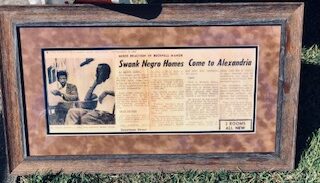
Homeowners Gave Jim Crow His Comeuppance
“From plantation to farm to subdivision,” mused Dan Storck, a member of the board of supervisors for Fairfax County, Va., outside Washington.
Storck was speaking at a ceremony Saturday organized by retired Los Angeles Times journalist Jube Shiver Jr., celebrating the county’s designation of Randall Estates as a “historic district,” whose developers navigated Jim Crow to make it one of the few Black subdivisions of its scope put together by African Americans for African Americans in the segregated South.
(Shiver’s research found fewer than a half dozen others, including Madonna Acres, a 13-acre subdivision of 40 custom homes developed between 1960 and 1965 by John Winters in Raleigh, N.C., and Collier Heights, started in 1948 by Herman Russell of Atlanta. Randall Estates, built in 1962 and 1963, had 42 homes over 20 acres.)
Shiver, who also worked at the old Washington Star, USA Today and The Washington Post, now runs the real-estate business founded by his late father, Jube Shiver Sr. Their house is the cornerstone of the development.
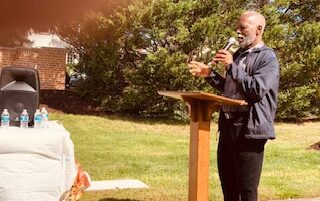 “We received this recognition, first and foremost, because this land that we are standing on — at least these two lots right here. . . — have been owned by African Americans for nearly 150 years. Ever since descendants of George Mason the IV, one of the founding fathers of this country, sold 10 acres of their land to Griffin Johnson, the Masons’ long serving coachman in 1874,” Shiver (pictured) told the 50 or so gathered, many of them original residents or their relatives.
“We received this recognition, first and foremost, because this land that we are standing on — at least these two lots right here. . . — have been owned by African Americans for nearly 150 years. Ever since descendants of George Mason the IV, one of the founding fathers of this country, sold 10 acres of their land to Griffin Johnson, the Masons’ long serving coachman in 1874,” Shiver (pictured) told the 50 or so gathered, many of them original residents or their relatives.
“It was no walk in the park building this community in the early 1960s during Jim Crow,” Shiver continued. “One of our guests today, [State] Sen. [Scott] Surovell, spearheaded an effort to get an historic marker erected a few hundred yards from here to recognize a bitterly fought Supreme Court case that led to the desegregation of the Bucknell Manor swimming pool, as well as other neighborhood clubs across the United States.
“Yet even after that court decision, one of our former neighbors in Randall Estates, James Lewis, the first head coach of the Washington Mystics women’s basketball team, was asked to leave the Bucknell Manor tennis court right next to the swimming pool after a white friend had invited him to come play tennis there. Even more poignantly, one of Randall Estate’s original home owners, William Carr, could not legally occupy the house he had built in 1965 for his kids and German-born wife, because of Virginia’s miscegenation laws. Those laws were eventually struck down by the U.S. Supreme Court in 1967 and dramatized in the 2016 Hollywood film ‘Loving‘.”
Surovell, one of the speakers, said he was a grandson of Jewish immigrants who arrived in 1935. Jews weren’t welcome in the area, either, so they joined the NAACP, he said.
Black children went to schools designated for Blacks only, sometimes miles from home. White neighbors tried to undermine plans for a Black subdivision that might have nicer homes than their own. Shiver’s dad was repeatedly frustrated in his efforts to secure bank loans, though he persevered.
“History does matter,” Storck said, referring to some of this struggle, “but we can change the future by what we do today.”
Asked whether his journalism background helped him win the historic designation, which requires the submission of narratives and undertaking research, Shiver told Journal-isms, “I don’t know. Maybe that I loaned my dad $3000 of my saved Washington Star salary in the late 70s that saved my dad’s business. But my dad seriously distrusted journalists.” No worries; none seemed to be assigned to cover the event.
For more background , go to https://mjfi.org/ and click “Resources.”
- Courtland Milloy, Washington Post: Lessons from a Black community that was built from scratch to succeed (Oct. 31)
- Mary Paden, Mount Vernon on the MoVe, Fairfax County, Va.: Historic designation won by subdivision built by Black entrepreneur during Jim Crow (Oct. 13)
Short Takes
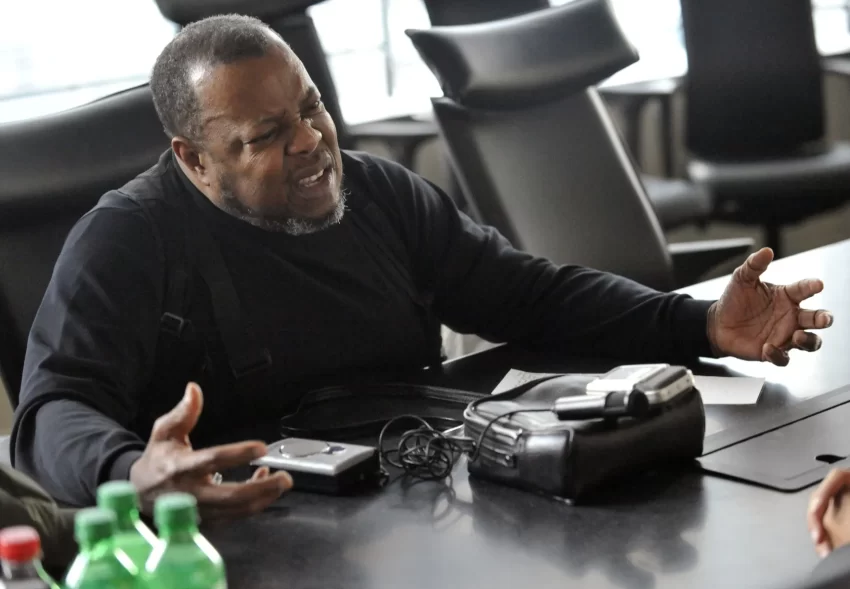
- “For decades, letting the world know the plight of Blacks in America fell on the shoulders of journalists like Fletcher Martin,” Mary Mitchell wrote Tuesday to help commemorate the 75th anniversary of the Chicago Sun-Times. “Martin became the first Black journalist to work with white journalists in the Sun-Times newsroom when he joined the staff as a reporter in 1952 after also being the first Black journalist to be awarded a prestigious Nieman Fellowship. . . . Mitchell also namechecked Lillian Calhoun, the first Black woman to work in the newsroom; Lillian Williams, who arrived in 1973; Lacy J. Banks, the newspaper’s first Black sportswriter; and Don Terry, who went on to The New York Times and is now the Chicago Police Department’s director of news affairs.
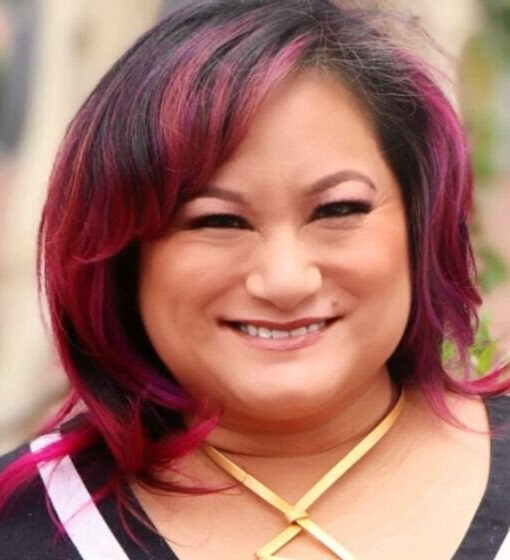 “In this episode of E&P Reports, we check in with Chicago Public Media, owners of PBS affiliate WBEZ, to find out how their 2022 acquisition of the 149-year-old Chicago Sun-Times is going“ [PDF], Editor & Publisher announced. “Appearing on the program are Jennifer Kho (pictured), executive editor for the newspaper and Tracy Brown, chief content officer for the parent company, who discuss their new initiatives, collaborative efforts and how the blending of these two major market brands is working to expand their audience.”
“In this episode of E&P Reports, we check in with Chicago Public Media, owners of PBS affiliate WBEZ, to find out how their 2022 acquisition of the 149-year-old Chicago Sun-Times is going“ [PDF], Editor & Publisher announced. “Appearing on the program are Jennifer Kho (pictured), executive editor for the newspaper and Tracy Brown, chief content officer for the parent company, who discuss their new initiatives, collaborative efforts and how the blending of these two major market brands is working to expand their audience.”
- The Driving Force, a 10-week internship designed for students interested in covering the automobile industry, is beginning its inaugural academic session with Florida A&M University’s (FAMU) School of Journalism & Graphic Communication this fall, the Black Automotive Media Group announced. It is sponsored by Hyundai Motor America. The HBCU Multimedia internship program continues at North Carolina Central University, sponsored by automobile manufacturer Stellantis.
- “New Jersey’s Robert Menendez is entitled to the presumption of innocence (again). But after his latest federal indictment on bribery charges, he should not be entitled to continue to serve in the United States Senate,” the Philadelphia Inquirer editorialized Sept. 26. “Menendez should resign. The cloud hanging over the Garden State’s senior senator will inevitably distract from his ability to put his constituents first. He should step down and focus his energy on mounting a credible defense. . . .”
- . . . Syndicated columnist Ruben Navarrette Jr. wrote, “Menendez is blaming the indictment on racism, insisting that he has been singled out as a high-profile Latino. Come again? As a Latino myself, I had no idea this guy was a member of the club. The senator often acts as a Democrat first and a Latino second. . . .”

- Monday is Indigenous Peoples Day, and the Associated Press’ Hallie Golden and Christine Fernando offer an explainer. Separately, “ICT has compiled a list of events that are free and open to the public, from California to New York, there is [an] Indigenous Peoples’ Day celebration happening near you. The events are organized by time zone and states or major cities. . ., ” Christopher Lomahquahu wrote.
- . . . . Despite “the atrocities inflicted on them, the day also serves as a reminder of how much the Indigenous community can teach non-Natives about living with each other and with the environment,” Rod Watson wrote Wednesday for The Buffalo News. “That educational effort is getting a major boost as the University at Buffalo ramps up its new Department of Indigenous Studies. . . . “
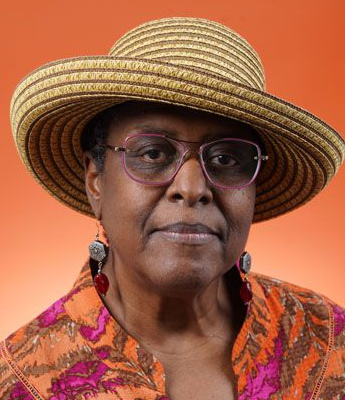 E.R. Shipp (pictured), an associate professor at Morgan State University who contributes to the Baltimore Banner, wrote Monday of takeaways from last week’s shooting at the school, where five were injured and others terrorized. “First is something that it is not popular to say in mixed company, so to speak. But it is what a caller named Dwayne said on WEAA the other day: In our families and in our neighborhoods, we must stop providing excuses and safe harbors for the bad actors in our midst. When people do what they did at Morgan — and worse — he said: ‘It is an assault against the community, which should be the worst crime that any Black person can commit.’ The second thing is what the best HBCUs have always done: expect and celebrate excellence. When I headed to my office in the School of Global Journalism and Communication after the chapel service, I stumbled upon a ceremony in which five alumni were being inducted into the Garden of Fame. Three of the more recent graduates included the recipient of a local Emmy Award and two Pulitzer Prize winners. These kinds of activities strengthen Morgan as an institution that is defined by its works — not by an October surprise that upended expectations for a festive Homecoming Week. . . .”
E.R. Shipp (pictured), an associate professor at Morgan State University who contributes to the Baltimore Banner, wrote Monday of takeaways from last week’s shooting at the school, where five were injured and others terrorized. “First is something that it is not popular to say in mixed company, so to speak. But it is what a caller named Dwayne said on WEAA the other day: In our families and in our neighborhoods, we must stop providing excuses and safe harbors for the bad actors in our midst. When people do what they did at Morgan — and worse — he said: ‘It is an assault against the community, which should be the worst crime that any Black person can commit.’ The second thing is what the best HBCUs have always done: expect and celebrate excellence. When I headed to my office in the School of Global Journalism and Communication after the chapel service, I stumbled upon a ceremony in which five alumni were being inducted into the Garden of Fame. Three of the more recent graduates included the recipient of a local Emmy Award and two Pulitzer Prize winners. These kinds of activities strengthen Morgan as an institution that is defined by its works — not by an October surprise that upended expectations for a festive Homecoming Week. . . .”
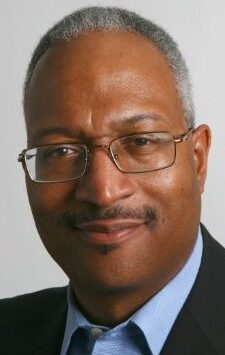 Mark Russell (pictured), executive editor of the Commercial Appeal in Memphis, Monday becomes vice president and South Region editor of the USA Today Network. Its South region has 17 newsrooms throughout Tennessee, Mississippi, North Carolina and South Carolina.
Mark Russell (pictured), executive editor of the Commercial Appeal in Memphis, Monday becomes vice president and South Region editor of the USA Today Network. Its South region has 17 newsrooms throughout Tennessee, Mississippi, North Carolina and South Carolina.
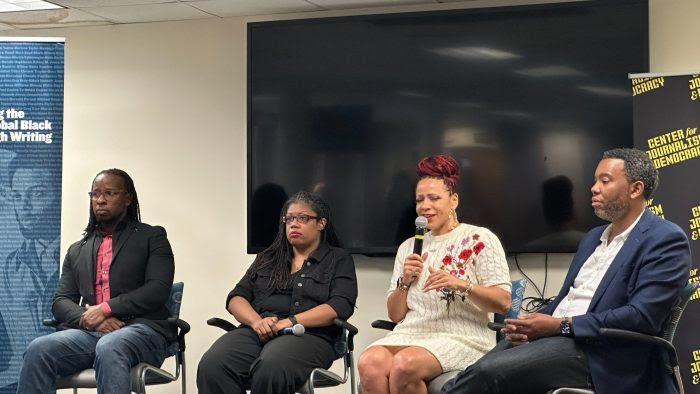
- “Howard University’s annual International Black Writers Festival hosted African-American authors who have faced bans on their books about the history of Black America and racism to speak about the opposition to their writings,” Takier George reported Thursday for Andscape. “Authors Mikki Kendall and Ibram X. Kendi joined Howard professors Nikole Hannah-Jones and Ta-Nehisi Coates . . . .” Separately, The Boston Globe Opinion section Thursday published an excerpt of Coates’ “Between the World and Me,” explaining, “In honor of Banned Books Week, Globe Opinion is publishing excerpts from some of the hundreds of titles banned in US classrooms and libraries this year.”
- “Alan Sealls, a mainstay of Mobile television for nearly 25 years as a meteorologist at WKRG and WPMI, will retire from the airwaves in January,” Howard Koplowitz reported Sept. 29 for al.com. “Sealls’ calm demeanor caused him to go viral on social media as Reddit users appreciated how the meteorologist analyzed Hurricanes Irma, Jose, and Katia on Sept. 6, 2017 without sensationalizing the storms. That clip went on to rack up well over 5 million views on YouTube. . . .”
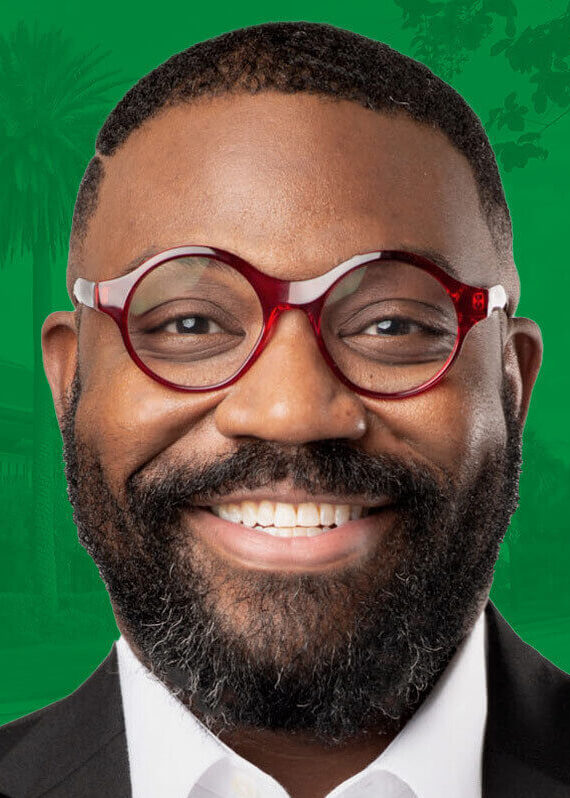 Kerwin Speight “started at the Poynter Institute on Sept. 29 as the newest faculty member, focusing on TV and broadcast journalism,” the institute announced. “He comes to Poynter from REVOLT Black News, and prior to that, Spectrum News in Charlotte.”
Kerwin Speight “started at the Poynter Institute on Sept. 29 as the newest faculty member, focusing on TV and broadcast journalism,” the institute announced. “He comes to Poynter from REVOLT Black News, and prior to that, Spectrum News in Charlotte.”
 “The Reporters Committee for Freedom of the Press has three new legal fellows — Zachary Babo, Julia Dacy, and Mayeesha Galiba (pictured) — who are to support the organization’s efforts to provide free legal services to journalists and news outlets through litigation, friend-of-the-court briefs, pre-publication review, the Legal Hotline, and more, the organization announced Sept. 28. “Galiba is the new NBCU News Group Race Equity in Journalism Legal Fellow. She will focus on providing pro bono legal support for journalists of color and newsrooms led by people of color. . . .”
“The Reporters Committee for Freedom of the Press has three new legal fellows — Zachary Babo, Julia Dacy, and Mayeesha Galiba (pictured) — who are to support the organization’s efforts to provide free legal services to journalists and news outlets through litigation, friend-of-the-court briefs, pre-publication review, the Legal Hotline, and more, the organization announced Sept. 28. “Galiba is the new NBCU News Group Race Equity in Journalism Legal Fellow. She will focus on providing pro bono legal support for journalists of color and newsrooms led by people of color. . . .”
- “October marks Black History Month in the UK, with this year focusing on the invaluable role that Black women have played in shaping history, inspiring change and building communities,” Katie Weston and Reanna Smith reported for Britain’s Mirror. “First celebrated in 1987, the event aims to explore African and Caribbean culture and history across the nation, from the Black communities that were present in Britain thousands of years ago, to the Black servicemen that aided the UK during the Second World War and the Windrush generation that arrived after them. . . . “
To subscribe at no cost, please send an email to journal-isms+subscribe@groups.io and say who you are.
Facebook users: “Like” “Richard Prince’s Journal-isms” on Facebook.
Follow Richard Prince on Twitter @princeeditor
Richard Prince’s Journal-isms originates from Washington. It began in print before most of us knew what the internet was, and it would like to be referred to as a “column.” Any views expressed in the column are those of the person or organization quoted and not those of any other entity. Send tips, comments and concerns to Richard Prince at journal-isms+owner@
View previous columns (after Feb. 13, 2016).
View previous columns (before Feb. 13, 2016)
- Diversity’s Greatest Hits, 2018 (Jan. 4, 2019)
- Book Notes: Is Taking a Knee Really All That? (Dec. 20, 2018)
- Book Notes: Challenging ’45’ and Proudly Telling the Story (Dec. 18, 2018)
- Book Notes: Get Down With the Legends! (Dec. 11, 2018)
- Journalist Richard Prince w/Joe Madison (Sirius XM, April 18, 2018) (podcast)
- Richard Prince (journalist) (Wikipedia entry)
- February 2018 Podcast: Richard “Dick” Prince on the need for newsroom diversity (Gabriel Greschler, Student Press Law Center, Feb. 26, 2018)
- Diversity’s Greatest Hits, 2017 — Where Will They Take Us in the Year Ahead?
- Book Notes: Best Sellers, Uncovered Treasures, Overlooked History (Dec. 19, 2017)
- An advocate for diversity in the media is still pressing for representation, (Courtland Milloy, Washington Post, Nov. 28, 2017)
- Morgan Global Journalism Review: Journal-isms Journeys On (Aug. 31, 2017)
- Diversity’s Greatest Hits, 2016
- Book Notes: 16 Writers Dish About ‘Chelle,’ the First Lady
- Book Notes: From Coretta to Barack, and in Search of the Godfather
- Journal-isms’ Richard Prince Wants Your Ideas (FishbowlDC, Feb. 26, 2016)
- “JOURNAL-ISMS” IS LATEST TO BEAR BRUNT OF INDUSTRY’S ECONOMIC WOES (Feb. 19, 2016)
- Richard Prince with Charlayne Hunter-Gault, “PBS NewsHour,” “What stagnant diversity means for America’s newsrooms” (Dec. 15, 2015)
- Book Notes: Journalists Follow Their Passions
- Book Notes: Journalists Who Rocked Their World
- Book Notes: Hands Up! Read This!
- Book Notes: New Cosby Bio Looks Like a Best-Seller
- Journo-diversity advocate turns attention to Ezra Klein project (Erik Wemple, Washington Post, March 5, 2014)

